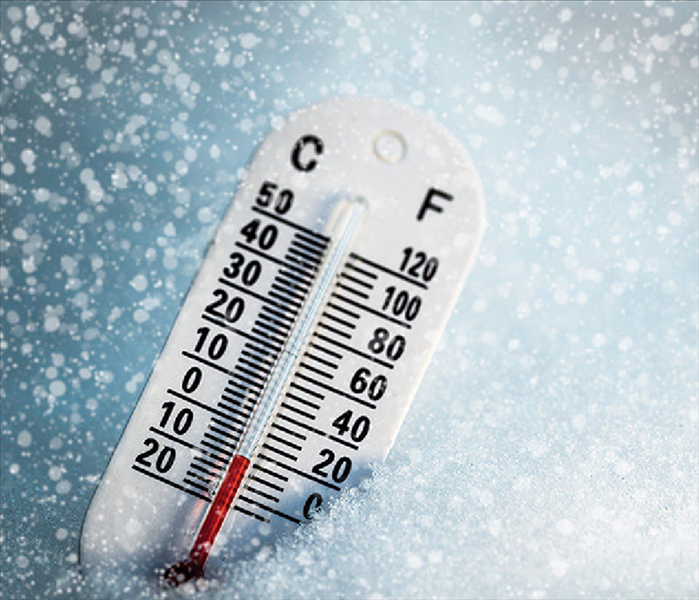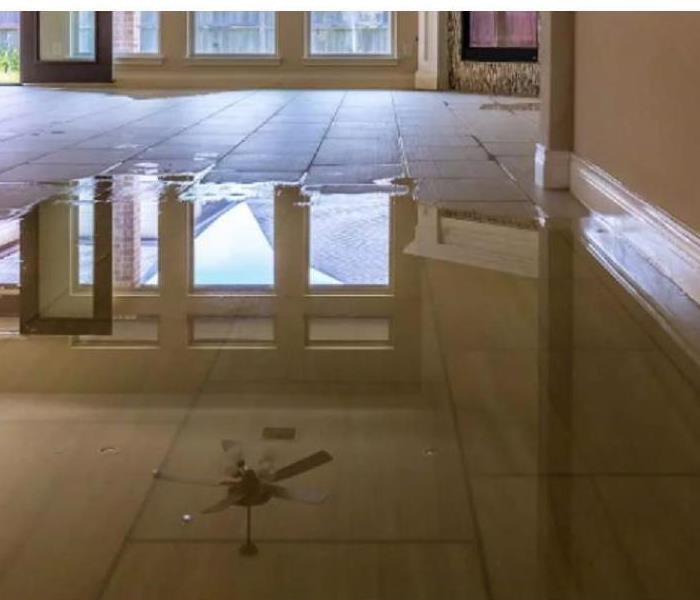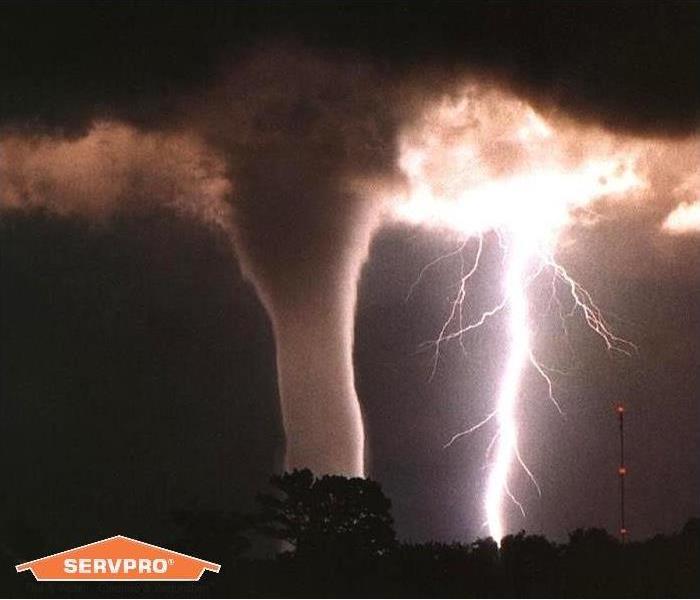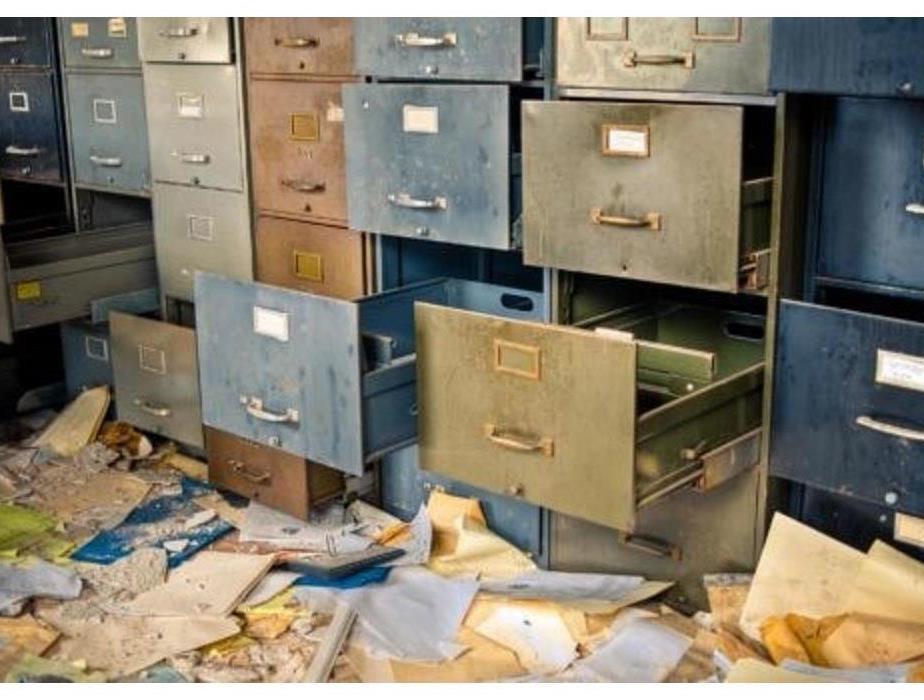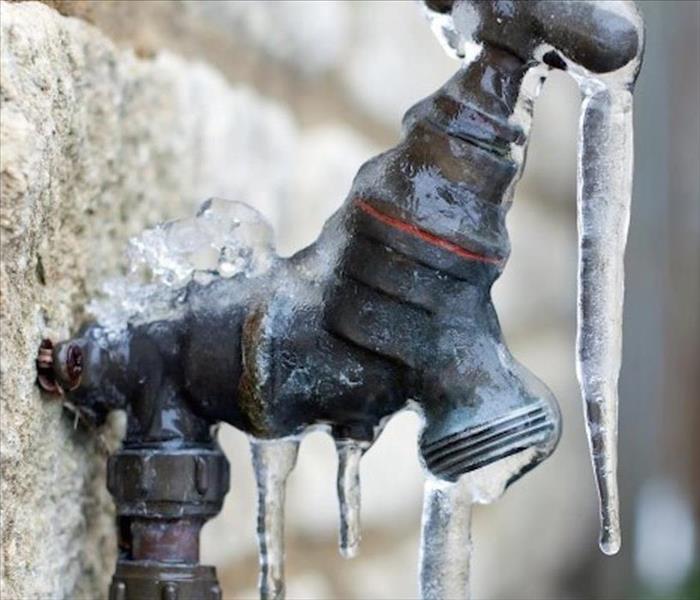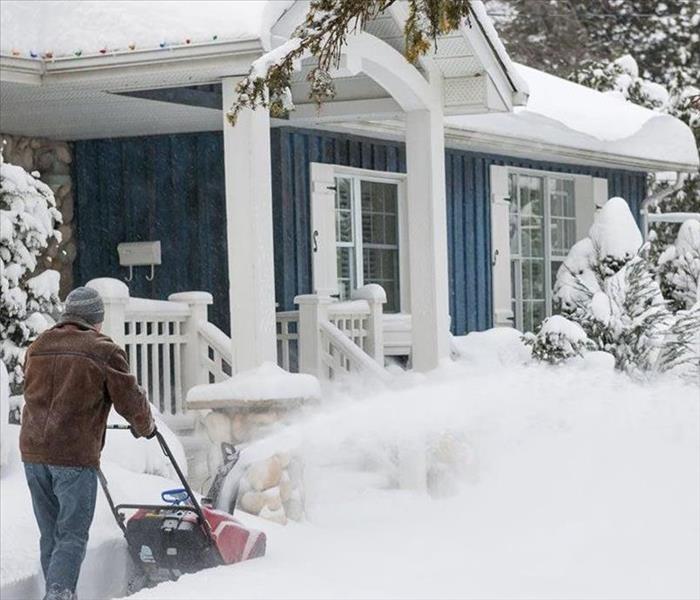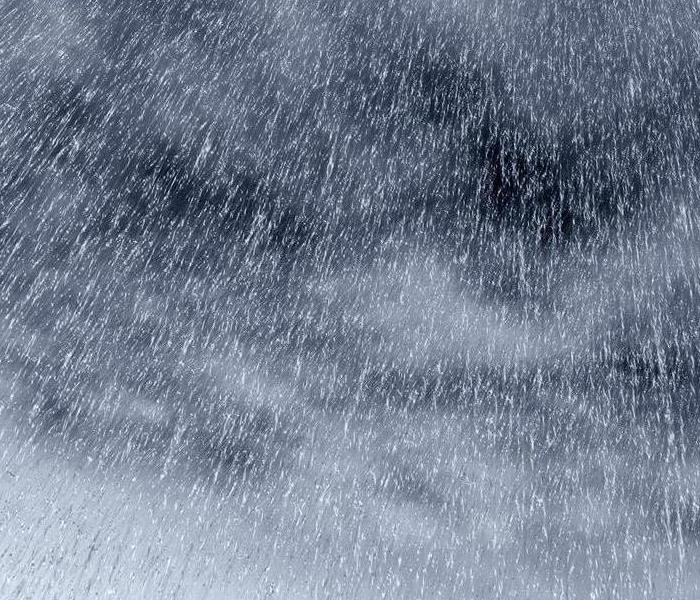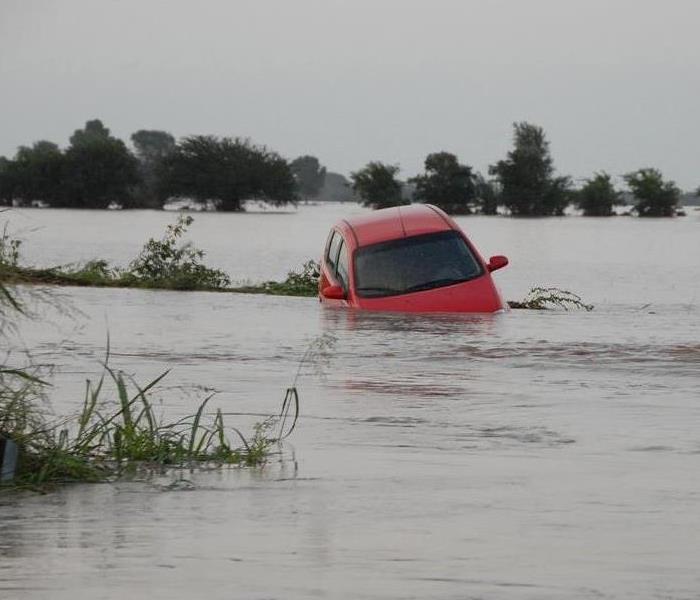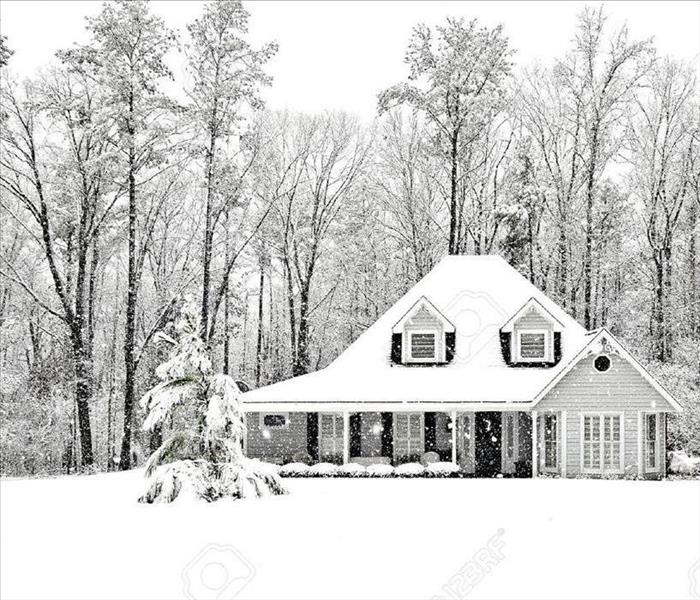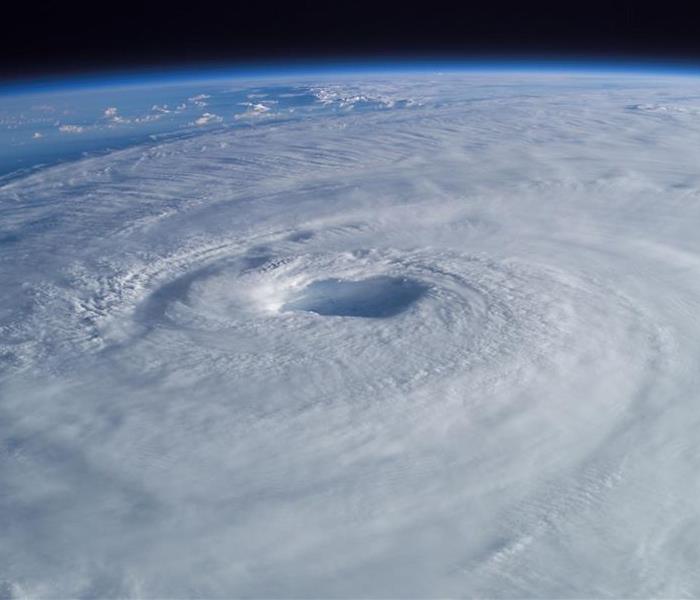Recent Storm Damage Posts
SERVPRO Storm and Wind Damage Response
3/23/2022 (Permalink)
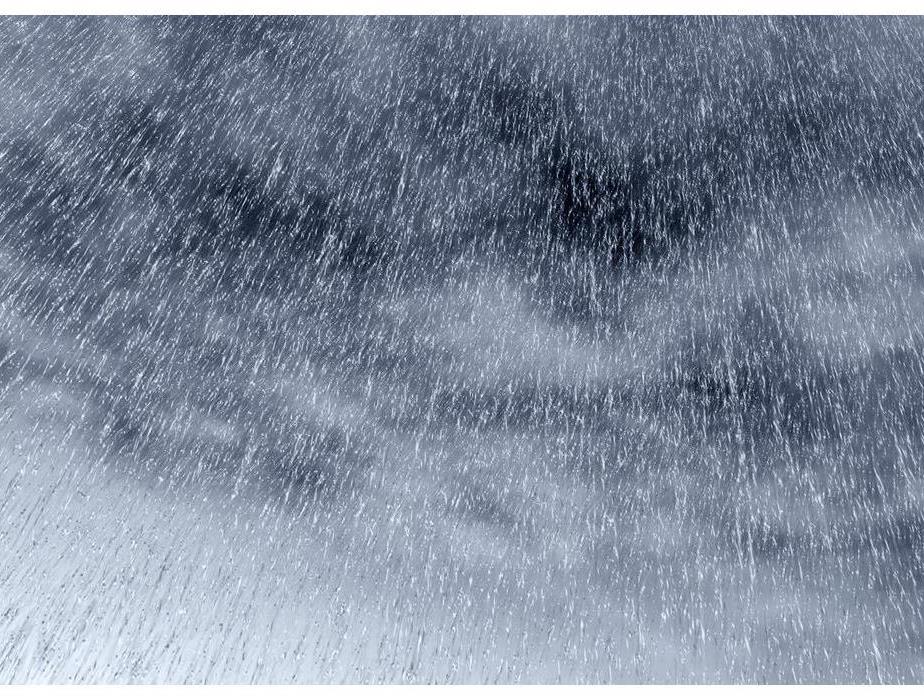
With the spring storm season approaching, it’s important to remember the potential damages wind, hail, and excessive rainwater can cause. Fallen trees, flooded basements, and damaged windows are only a few of the effects a large storm can have on a home or business. When you find yourself with property damage after a big storm, SERVPRO is here to help. With a strategic network of Disaster Recovery Teams on standby, SERVPRO is able to respond to hurricanes, blizzards, tornadoes, or floods 24 hours a day 365 days a year. SERVPRO technicians have advanced training as well as plenty of hands-on experience when dealing with storm damages that ensure your home will be quickly dried and restored to pre-storm condition. Being locally owned and operated, we at SERVPRO aim to maintain fast service response to ease your worries about your home or property after a storm. Weather may be unpredictable, but SERVPRO can ensure a detailed and speedy cleanup of damages any time, any day.
Watch out for Frozen Pipes!
2/16/2022 (Permalink)
Temperatures this Winter have fluctuated a lot. Today could be single digits and later in the week it gets all the up to 50 degrees. The weather break can be nice for the Spring and Summer lovers but not for your pipes. When pipes are exposed to subfreezing temperatures, the water inside freezes and expands the pipes; in some cases when the pressure it too much they might burst. If they don’t burst from the frozen water pressure, when it gets drastically warmer and the water thaws quickly, the additional of the melting water may cause the pipes to burst. This can cause severe damage to walls, ceilings, floorings, interior and increase mold growth. Which leads to even more problems.
But we can’t control the weather and water damage cost thousands to repair. So, here are some tips to help prevent pipe burst.
- Keep pipes insulated by wrapping foam insulation around them.
- Seal up cracks and leaks to keep out the cold air as much as possible.
- Open the doors inside your home to allow the heat to move efficiently through the house.
- Keep the heat set to no longer than 50 degrees Fahrenheit even if you won’t be home. If the house is warm, it can prevent the pipes from freezing.
Tips listed above are provided from Simply Most https://www.simplemost.com/7-tips-prevent-your-pipes-from-bursting-winter/.
If You Experience a Flood…Call SERVPRO!
2/16/2022 (Permalink)
The Binghamton area hasn’t seen any major flooding since 2011 but floods happen more often than we think. According to CBS News, 1 in 10 homes across the U.S. is likely to experience a flood. There are multiple factors that can cause floods in homes such as broken/burst pipes, poor drainage, clogged rain gutters, damaged foundation, and malfunctioning appliances. Simple mistakes like leaving a faucet on for too long can also cause floods. Water can cause severe damage and be costly to repair.
But what should you do if you experience flooding inside your home? Make SERVPRO your first choice to help you. Whether it’s 2 am or 2 pm our team is on call and ready to assist when a disaster strikes. Water can spread quickly throughout your property causing more damage as it spreads and create breeding grounds for mold. But once we get on site, we start the water extraction and dehumidification process immediately. We have advanced training, experience, and the latest technology and equipment to provide a good, fast, and efficient job. Our goal is to restore your home to how it was prior to any water damage. In the event, you should have mold infestation along with water damage, we are trained and equipped to handle that as well. So, if you should experience flooding, let us help you restore your property as if it never ever happened.
Hail Damage and your Property!
4/1/2021 (Permalink)
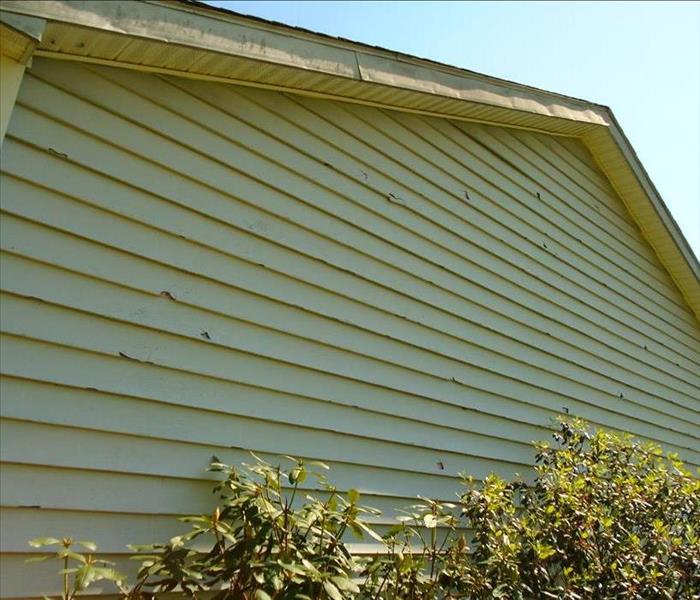 Hail damage to siding of a customers home. SERVPRO's ReconstructionTeam completed repairs to damaged windows, siding and roof.
Hail damage to siding of a customers home. SERVPRO's ReconstructionTeam completed repairs to damaged windows, siding and roof.
There are many storms and natural occurring events that can impact your property. Flooding, thunderstorms, wind, wildfire, mudslides, hurricanes, tornadoes, and hail damage. Some areas of the US are more susceptible to certain types of disasters than others, but when it comes to flooding and hail these affect most areas throughout the country.
Hail can be anywhere from ¼ inch in size to 4 ¼ inch in size. On Average it is more commonly under an inch in diameter, with the largest on record being close to 8 inches, according RMIIA.
Hail can cause severe damage to property, automobiles, and Crops. Larger hail can break windows, damage siding, and roofs. According to statistics culled from NOAA's Severe Storms database There were 5,382 major hail storms in 2019, In 2018, 4.610 major hailstorms occurred, resulting in $810 million in property and crop damage.
How can SERVPRO Help? Following a major storm such as flooding, our mitigation specialists are out there in affected communities until the cleanup is done. With Storms that cause roof, window and siding damage, our Repair Coordinators are out there providing Roof Tarps and Board ups and securing properties from further damage. Exterior damage and easily turn into interior damage, broken skylight windows & damaged roofs can leave your property vulnerable to water damage and mold. Our Team can respond and provide emergency services, moisture readings, and help determine the root of the issue and what it will take to get your property whole again.
Spring Weather & Storm Preparedness
3/17/2021 (Permalink)
Spring is the time of year when many things change, including weather. Temperatures can swing back and forth between warm and downright frigid. Sunny days may be followed by a week of stormy weather. Sometimes extreme weather changes can occur even within the same day.
Whenever warm, moist air collides with cool, dry air, the possibility for a thunderstorm is present. Although thunderstorms may be “common” in many regions, storms can come on with little to no warning and leave devastating effects. Thunderstorms can bring lightning, heavy rain, hail and high winds. In more extreme conditions even tornadoes can occur.
Because spring weather is so unpredictable, many can be caught unprepared. When severe weather hits unexpectedly, the risk of property damage, personal injury and death increases. So planning ahead makes sense; prepare for storms, floods, and tornadoes as if you know in advance they are coming.
Often by the time we are aware of an approaching storm, we have little if any time to prepare for it. Proactive planning for severe storms can be crucial for both enduring and rebuilding after the storm. According to the American Red Cross, recommended items to include in your storm planning;
- A battery-operated flashlight, a battery-operated NOAA Weather Radio, and extra batteries for both
- An emergency evacuation or shelter plan, including a map of your home and, for every type of severe weather emergency, routes to safety from each room
- A list of important personal information, including:
- telephone numbers of neighbors, family, and friends
- insurance and property information
- telephone numbers of utility companies
- medical information
- According to the American Red Cross a first aid kit should may include:
- non-latex gloves
- assortment of adhesive bandages
- antibiotic ointment
- sterile gauze pads in assorted sizes
- absorbent compress dressings
- tweezers
- scissors
- adhesive cloth tape
- aspirin packets (81 mg each)
- first aid instruction booklet
- A 3–5 day supply of bottled water and nonperishable food
- Personal hygiene items
- Blankets or sleeping bags
Prepare your family, home or business for the possibility of severe weather. Have a plan to endure the storm. Know who to call to help pick up the pieces. Your local SERVPRO franchise is a 24 hour emergency fire and water mitigation company and ready to assist you. SERVPRO Storm services include but are not limited to:
-Water extraction
-Dehumidification and air filtration services
-Contents cleaning and pack out services
-Structural evaluation and board-up
-Reconstruction planning and services
What happens to your belongings after a storm?
1/26/2021 (Permalink)
Storm and water damage not only affects a home structure, but also the contents within the home. Whether it’s just furniture, or precious photographs and important documents, SERVPRO of Broome, Tompkins & Tioga Counties and SEVRPRO of Elmira/Chemung County & Watkins Glen/Schuyler County can help you restore all your contents to preloss condition. We offer five different methods of cleaning your contents:
- Dry Cleaning – This method is used for cleaning light residues or to pre-clean prior to cleaning.
- Wet Cleaning – This is an effective cleaning method used for removing moderate to heavy residues.
- Spray & Wipe – Effective for items that cannot withstand cleaning.
- Foam Cleaning – Used for upholstery fabrics that might shrink or bleed if cleaned.
- Abrasive Cleaning – Involves agitation of the surface being cleaned.
- Immersion Cleaning – The soiled contents are dipped into a bath of the cleaning product.
When your valuable documents, including photographs, are damaged by water, extreme caution should be taken to help insure the water damage does not destroy the document. Although some documents may not be restored to pre-water damage condition, SERVPRO can save a great deal and minimized additional damage. Depending on the type of documents and the level of water damage, there are five options for the restoration of documents.
- Air Drying
- Dehumidification
- Freeze Drying
- Vacuum Freeze Drying
- Vacuum Thermal Drying
Call SERVPRO of Broome, Tompkins & Tioga Counties and SERVPRO of Elmira/Chemung County & Watkins Glen/Schuyler County at 607-722-2262 to learn more about how we can help restore your items and documents.
Winter Warnings Vs. Watches
1/3/2021 (Permalink)
The labels of storm watches & warnings flash across our screens on a consistent basis, but do you know what each one means?
Winter watches are conditions favorable for a winter storm event, which is a threat to life and/or property. They are issued in advance of the storm, which is usually 24 hours. This indicates the risk of a hazardous winter weather event has increased (at least 50% chance of it occurring), but it’s occurrence, location and/or timing is still uncertain. This alert is intended to provide enough lead time to make plans in order to stay safe.
An advisory is issued for one or more of the following:
- Snow of 3-5 inches in 12 hours
- An accumulation of more than ½” of sleet
- Freezing rain with sleet/snow
- Blowing snow
As the event becomes more imminent, a watch would usually be upgraded to an advisory (which indicates an 80% or greater probability of occurrence. An advisory indicates conditions that pose a significant inconvenience, and if caution is not exercised, it could lead to situations that may threaten life and/or property.
Warnings are issued for one or more of the following:
- Heavy snow of 6 inches in 12 hours or 8 inches in 24 hours
- Sleet of ¼” or more
- Ice accumulation of ¼” or more
- Blizzard conditions for at least three hours
A warning indicates the conditions pose a threat to life and property, and that travel will become difficult to impossible. These are statements made when there is currently a winter storm occurring or is about to occur in the area.
Your Property and Getting Ready for Winter
11/17/2020 (Permalink)
The cold is finally here, which means increased risk in potential damages happening within your properties. Here at SERVPRO of Broome County, Tompkins & Tioga Counties, SERVPRO of Elmira/Chemung and Watkins Glen/Schuyler Counties want to offer you some tips that can help you winterize your homes and businesses in order to minimize any damages or losses that can occur in a moment’s notice.
It’s important to professionally maintain your heating and air conditioning units throughout the year, but winter is the time to take the extra step to make sure your heating system is prepared for overdrive. Problems such as an airlock, thermostat issues, leakage, and dripping may mean the system is not running efficiently. If your property has heating ducts, check them to see if the insulation needs to be replaced. While you should be cleaning and replacing your furnace filters every three months, winter is the prime time to change those out as clogged and dirty filters can restrict airflow, resulting in the system working harder than it should.
Make sure that you test all your smoke and carbon monoxide detectors around the property. Regularly replacing batteries for smoke and carbon monoxide detectors is a good practice for winter preparedness.
Drain outside faucets. They are completely unprotected from the elements and can freeze over the winter which could split the water line well inside the property – flooding a basement. Not to mention the potential of extreme leaks occurring. Frozen pipes that burst are one of the biggest cause of property loss and damage during the winter.
Check the trees surrounding your property, and make sure that they are healthy so the possibility of them falling on a structure is minimized. Trim the branches close to the siding and windows so there are no ice-covered branches near them.
Clean the gutters and ensure that the roof is in a good condition in case it has to handle heavy snowfall.
Severe winter weather can lead to property damage, injury, and possible business closure. At SERVPRO of Broome County, Tompkins & Tioga Counties and SERVPRO of Elmira/Chemung and Watkins Glen/Schuyler Counties, were here to make sure that you are prepared and in good hands, through the rain, snow, and sun, 24/7! Give us a call at 607-722-2262 for free estimates and other professional services.
Thunderstorm & Tornado Safety
7/20/2020 (Permalink)
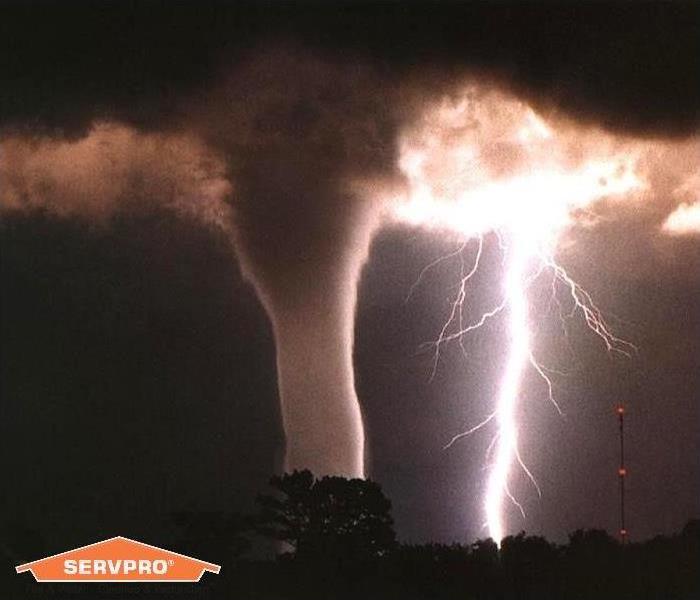 Tornado and Lightning Strike Hard
Tornado and Lightning Strike Hard
Why worry about thunderstorms?
- Lightning
- Tornadoes
- Straight-line winds
- Flash floods and floods
- Hail
A thunderstorm affects a relatively small area when compared to a hurricane or a winter storm. The typical thunderstorm is 15 miles in diameter and lasts an average of 30 minutes. Despite their small size, ALL thunderstorms are dangerous! Of the estimated 100,000 thunderstorms that occur each year in the United States, about 10 percent are classified as severe.
Who's Most At-Risk from Thunderstorms?
From tornadoes, people who are in mobile homes our outdoors.
From lightning, people who are outdoors or anyone who stays outdoors when thunderstorms are nearby.
From flash flooding, people who walk or drive through flood waters.
From large hail, people who are caught outdoors.
Be Prepared
Each year, many people are killed or seriously injured by tornadoes and severe thunderstorms despite advance warning. Some did not hear the warning; others heard the warning but did not believe it would happen to them. The following preparedness information, combined with timely severe weather watches and warnings, may save your life. If you hear a warning or observe threatening skies, only YOU can make the decision to seek safety. This could be the most important decision you will ever make.
Develop a plan for you and your family at home, work, school and when outdoors. The American Red Cross offers tips at redcross.org, and the Federal Emergency Management Agency (FEMA) at ready.gov.
When Dangerous Weather Approaches
Avoid the Lightning Threat
- Have a lightning safety plan. Know where you'll go for safety and how much time it will take to get there. Make sure your plan allows enough time to reach safety.
- Postpone activities. Before going outdoors, check the forecast for thunderstorms. Consider postponing activities to avoid being caught in a dangerous situation.
- Monitor the weather. Look for signs of a developing thunderstorm such as darkening skies, flashes of lightning or increasing wind.
- Get to a safe place. If you hear thunder, even a distant rumble, immediately move to a safe place. When thunder roars, go indoors! Fully enclosed buildings with wiring and plumbing provide the best protection. Sheds, picnic shelters, tents or covered porches do not protect you from lightning. If a sturdy building is not nearby, get into a hard-topped metal vehicle and close all the windows. Stay inside until 30 minutes after the last rumble of thunder.
- If you hear thunder, don't use a corded phone. Cordless phones, cell phones and other wireless handheld devices are safe to use.
- Keep away from electrical equipment, wiring and water pipes. Sensitive electronics should be unplugged well in advance of thunderstorms. Don't take a bath, shower or use other plumbing during a thunderstorm.
When Caught Outside During Thunder
There is no safe place outside during a thunderstorm. Plan ahead to avoid this dangerous situation! If you're outside and hear thunder, the only way to significantly reduce your risk of becoming a lightning casualty is to get inside a substantial building or hard-topped metal vehicle as fast as you can. Remember, there is no substitute for getting to a safe place.
- Avoid open areas and stay away from isolated tall trees, towers or utility poles. Do not be the tallest object in the area. Lightning tends to strike the tallest objects in the area.
- Stay away from metal conductors such as wires or fences. Metal does not attract lightning, but lightning can travel long distances through it.
Top 10 safety tips for working in the heat!
7/20/2020 (Permalink)
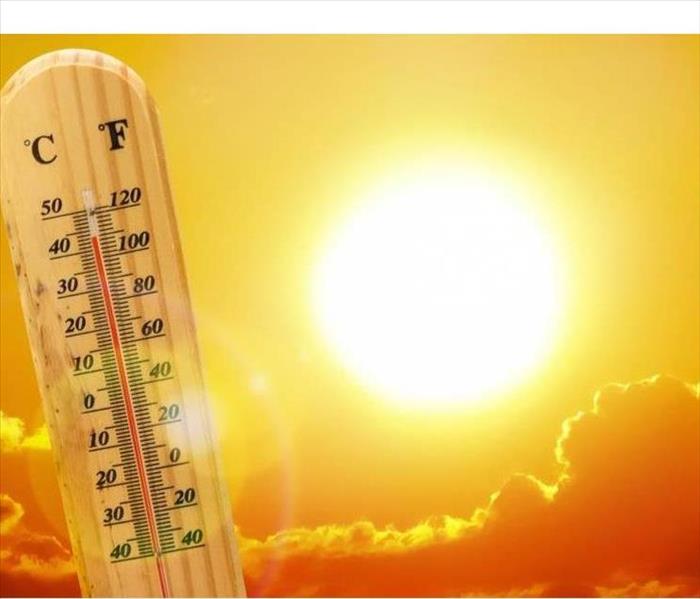 The Temperature is rising. Stay Cool!
The Temperature is rising. Stay Cool!
As summer approaches and the days get longer, the dangers of working outside during hot weather also increases. Knowing how to work safely in hot weather can help prevent heat stress injuries and heat stroke. According to the National Institute for Occupational Safety and Health (NIOSH), heat stroke is the most serious heat-related disorder and occurs when the body can no longer control its temperature. The body temperature can rise to 106 degrees Fahrenheit or higher within 10 to 15 minutes and heat stroke can cause death or permanent disability if emergency treatment is not provided. Other heat-related disorders include heat exhaustion, heat cramps and heat rash.
Be prepared for the hot weather with these tips!
Ten Hot Weather Safety Tips:
- Stay hydrated. Drink plenty of fluids; drink about 16 ounces before starting and 5 to 7 ounces every 15 or 20 minutes.
- Avoid dehydrating liquids. Alcohol, coffee, tea and caffeinated soft drinks can hurt more than help.
- Wear protective clothing. Lightweight, light-colored and loose-fitting clothing helps protect against heat. Change clothing if it gets completely saturated.
- Pace yourself. Slow down and work at an even pace. Know your own limits and ability to work safely in heat.
- Schedule frequent breaks. Take time for rest periods and water breaks in a shaded or air conditioned area.
- Use a damp rag. Wipe your face or put it around your neck.
- Avoid getting sunburn. Use sunscreen and wear a hat if working outside.
- Be alert to signs of heat-related illness. Know what to look for and check on other workers that might be at high risk.
- Avoid direct sun. Find shade or block out the sun if possible.
- Eat smaller meals. Eat fruits high in fiber and natural juice. Avoid high protein foods.
Now that you know how to 'beat the heat', here's to hoping you stay healthy and cool this summer!
SERVPRO: HERE FOR YOU 24/7
7/6/2020 (Permalink)
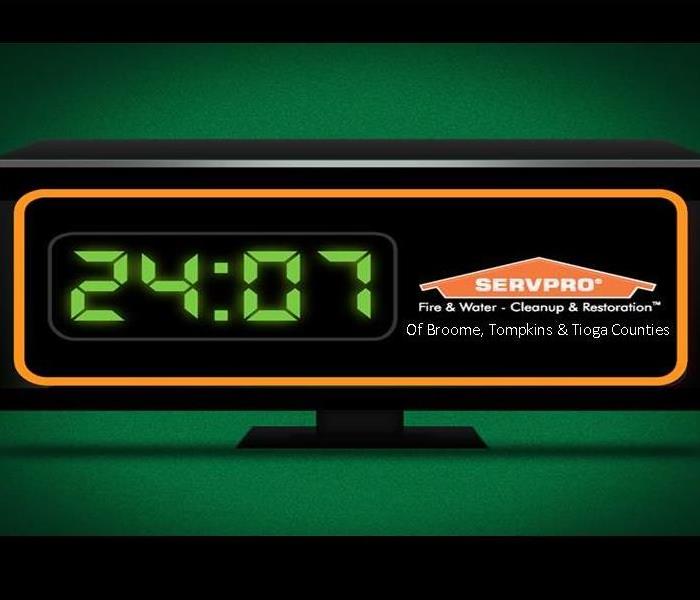 Here to help, anytime, day or night.
Here to help, anytime, day or night.
Flooding and water emergencies don’t wait for regular business hours, why would we? As your local SERVPRO we pride ourselves on our proximity and response times, during your emergency. Every second counts (and costs), we know that, and we make it our duty to not waste even one.
Emergencies happen. They can be unpredictable. They can be scary. They can be beat.
SERVPRO’s team of highly trained employees never stop preparing. Each and every SERVPRO team member has been thoroughly trained on fire restoration, water restoration, carpet & upholstery cleaning, and mold mitigation before stepping foot into the field. Together we can beat your emergency.
The fast response times by our highly trained employees are only possible because of our state of the art Fleet of response vehicles. Our fleet of cars, vans, pickup trucks, flatbed trucks, dumpsters trucks, and trailers, provide a vessel outfitted for your specific needs ready at the turn of a key.
We put the best people, in the best locations, and give them the best resources because our clients deserve nothing but the, you guessed it, best.
Be flood-smart - Reduce your risk
3/20/2020 (Permalink)
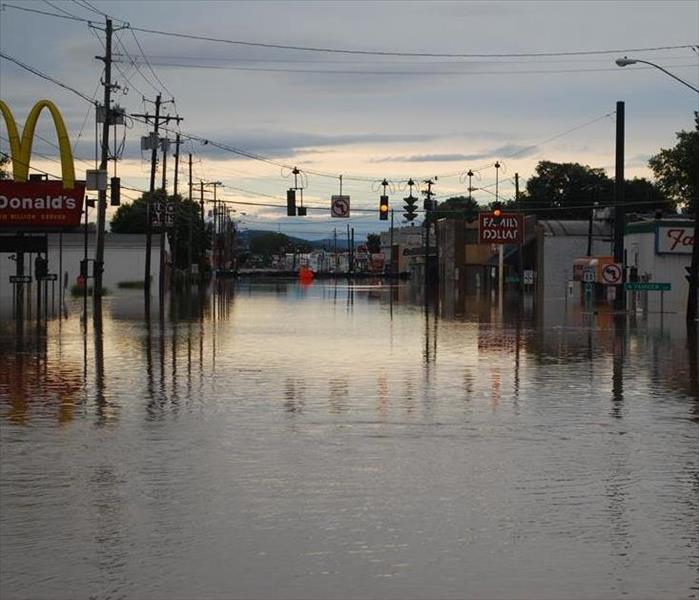 Stay informed and stay prepared
Stay informed and stay prepared
Ready.gov has great tips on how to be flood smart and reduce your risk of being unprepared. See below for some suggestions on how to be better prepared this spring storm season.
A flood does not have to be a catastrophic event to bring high out-of-pocket costs, and you don’t have to live in a high-risk flood area to suffer flood damage. Around twenty percent of flood insurance claims occur in moderate-to-low-risk zones. Property owners should remember: ? The time to prepare is now. Visit ready.gov/floods for more on family preparedness for flood and other emergencies.
There are a number of steps individuals and families can take to better prepare themselves for flooding and reduce their risks. Remember to have a family evacuation plan, put an emergency kit together, and keep important papers and valuables in a safe, dry place. Gather supplies in case of a storm, strengthen your home against damage, and review your insurance coverages.
Only flood insurance covers flood damage. Most standard homeowners policies do not cover flood damage. Remember: it typically takes 30 days for a new flood insurance policy to go into effect, so get your policy now.. Visit floodsmart.gov (or call 1-800-427-2419) to learn more about individual flood risk, explore coverage options, and to find an agent in your area.
Before A Flood
Practice your family emergency plan. Plan and practice flood evacuation routes from home, work, and school that are on higher ground.
Conduct a thorough home inventory. Thorough documentation of your belongings will help you file your flood insurance claim. For more information, visit http://www.ready.gov/insurance-vitalrecords.
Your local SERVPRO restoration specialists are happy to serve you 24 hours a day/7 days a week. If you experience a flood damage in your home or business, please call (607) 722-2262.
Spring Forward with Preparedness!
3/2/2020 (Permalink)
 Spring flowers growing despite the snow
Spring flowers growing despite the snow
Well, it is almost time to spring forward and gain an extra hour of sunlight! March brings many things, including longer days, warmer temperature (sometimes) and unpredictable weather.
Living in upstate NY, we always get hit with one more snow storm just when we think we are on the path to spring. Checking the farmer's almanac, here is what we can expect up north. According to weather folklore, if March “comes in like a lion, it goes out like a lamb.” This seems to hold true again this March. Even though the weather is supposed to get increasingly warmer, there may still be a mid-March snowstorm to send us on our way. There is even a possibility that we may have snow on our first day of spring. March 19th is the earliest spring we've ever had!
Although the weather is ever-changing, one thing that can stay constant is how prepared you are for any kind of weather. Check out your farmers almanac and see what you're hometown may experience this spring and summer. Be like your local SERVPRO restoration team and be, "Ready for whatever happens" this spring!
Spring weather is coming; tips to get prepared for whatever comes your way!
2/28/2020 (Permalink)
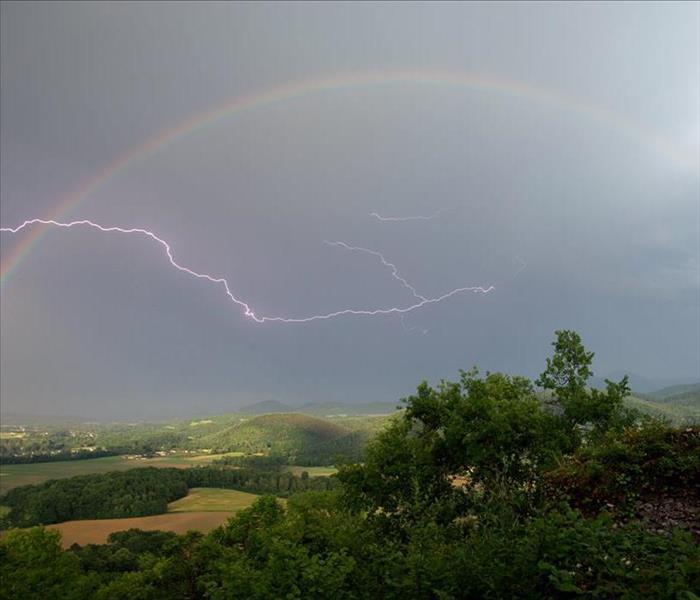 Stormy spring weather with a Rainbow
Stormy spring weather with a Rainbow
Spring is the time of year when many things change—including the weather. Temperatures can swing back and forth between balmy and frigid. Sunny days may be followed by a week of stormy weather. Sometimes extreme weather changes can occur even within the same day.
Advance planning for thunderstorms, lightning, tornadoes, and floods requires specific safety precautions. You can follow many of the same steps that you would for all extreme weather events. Keep an emergency kit on hand. According to CDC.gov, some items to include are:
- A battery-operated flashlight, a battery-operated NOAA Weather Radio, and extra batteries for both
- An emergency evacuation or shelter plan, including a map of your home and, for every type of severe weather emergency, routes to safety from each room
- A list of important personal information, including:
- telephone numbers of neighbors, family, and friends
- insurance and property information
- telephone numbers of utility companies
- medical information
- According to the American Red CrossExternal a first aid kit may include:
- non-latex gloves
- assortment of adhesive bandages
- antibiotic ointment
- sterile gauze pads in assorted sizes
- absorbent compress dressings
- tweezers
- scissors
- adhesive cloth tape
- aspirin packets (81 mg each)
- first aid instruction booklet (NOTE: Customize your first aid kitExternal to meet your individual and family needs.)
- A 3–5 day supply of bottled water and nonperishable food
- Personal hygiene items
- Blankets or sleeping bags
- An emergency kit Cdc-pdf[1.08 MB] in your car
Often by the time we are aware of an approaching storm, we have little if any time to prepare for it. But we do know that when spring arrives, thunderstorms, tornadoes, and floods are real possibilities. So why not take the surprise factor out of severe weather and prepare yourself, your family, and your home? If thunderstorms, tornadoes, and floods do occur, you’ll be ready for them.
Have piece of mind knowing that you have SERVPRO franchise professionals in your community who can assist you anytime day or night. We are available 24 hours a day to serve you and help make it, "Like it never even happened."
Call us today if you experience any storm damage to your home or business. Our trained technicians are ready and awaiting your call. (607) 722-2262.
House and Outdoor Winter Storm Prep Tips
12/24/2019 (Permalink)
Winter is here!
We know with large snow storms and freezing rain it can be dangerous for travel and house-care. SERVPRO wants to remind you of some handy tips to stay safe this winter season.
-Put salt down on your driveway and sidewalks. It is hard to see black ice and misjudge your traction on slippery snow.
-Shovel snow periodically to avoid mass build-up. The snow can get dense and heavy over long periods of accumulation.
-Ice removal is time consuming, leaving many car windows poorly cleared. To eliminate this problem, cover your car windows with cardboard before an ice storm.
-Prepare for power outages. It is a good idea to have non-perishable food, flashlights, batteries, firewood, and blankets handy in case of a power outage. Any supplies that require minimal energy should be stored to stay warm and healthy in a storm.
-Have your chimney inspected by a trained professional to assure all parts are working correctly. Eliminate the risk for fire problems throughout the winter season.
We are also available for help 24 hours a day 365 days a year if you ever need assistance. There is no disaster we are not prepared for. Happy Holidays!
https://www.aginginplace.org/winter-home-safety-tips-for-seniors-to-prepare-your-home/
Winter Weather: Storm Prep
11/26/2019 (Permalink)
Can we really prepare our businesses for Winter Storms?
Yes! Here are some tips of what can be done in advance of a storm in order to protect your property and liabilities.
- Check for down tree limbs and branches around your property. Weather such as wind, heavy rain, snow and ice can cause branches to fall which could potentially cause damage to the property and even potentially cause personal injuries.
- Check walkways and parking lots around property for proper drainage to alleviate flood hazard potential.
- Install mats or non slip surfaces and post caution signs where water could be present. Inspect handrails, stairwell and entry ways to address and correct potential slipper or hazardous areas.
Call on your local SERVPRO today about starting a free Emergency Ready Profile for your commercial business. We are here to help.
Flood Safety-Protecting your family
8/12/2019 (Permalink)
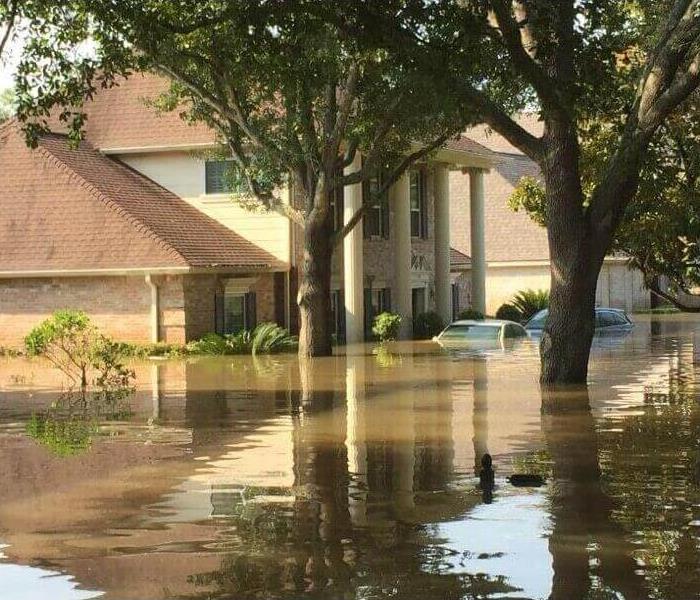 Flood Safety Tips
Flood Safety Tips
Be Ready for Whatever Happens! Prepare before a flood hits and start by Protecting Your Family with these tips from the American Red Cross.
- Talk with your family about what to do if a flood watch or warning is issued. Discussing floods ahead of time helps reduce fear, especially for younger children.
- Make sure you have access to NOAA radio broadcasts:
- Find out if you are located in a floodplain, which is considered a Special Flood Hazard Area. If so, you are still eligible for flood insurance. Check with your city or county government (start with the Building or Planning Department) to review the Flood Insurance Rate Maps, published by the Federal Emergency Management Agency (FEMA).
- Find out if local streams or rivers flood easily.
- Keep insurance policies, documents, and other valuables in a safe-deposit box. You may need quick, easy access to these documents. Keep them in a safe place less likely to be damaged during a flood. Take pictures on a phone and keep copies of important documents and files on a flashdrive that you can carry with you on your house or car keys.
SERVPRO of Broome, Tompkins & Tioga Counties is ready to assist you and your loved ones, anytime day and night. If your home or business experiences damage during a storm situation our team is qualified and ready to help!
Stay prepared by reading more tips below.
https://www.redcross.org/get-help/how-to-prepare-for-emergencies/types-of-emergencies/flood.html
SERVPRO Storm Response
7/31/2019 (Permalink)
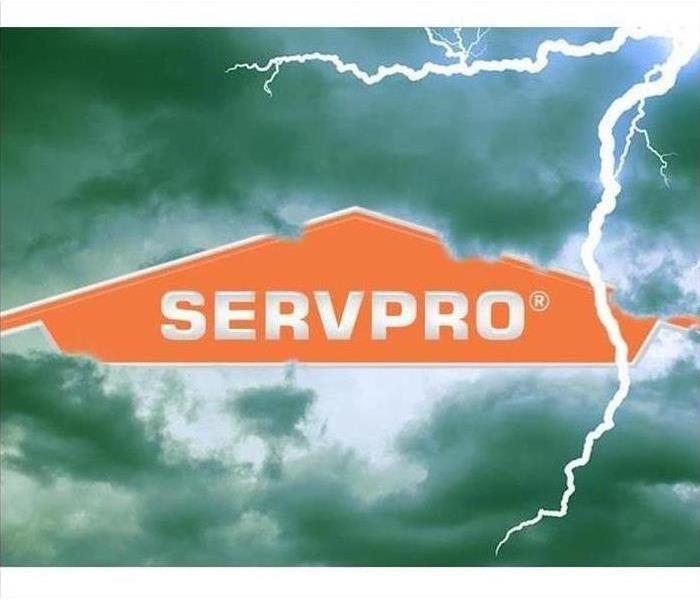 Storm Response available 24/7
Storm Response available 24/7
When it comes to fire & water damage, or specialty cleanup needs, your local SERVPRO team should be the first that comes to mind. Our TEAMS work endlessly to make sure our customers are happy, and have one objective in the aftermath of disaster, to make their loss Like it never even happened.
No matter the job or the size, our SERVPRO teams are ready to handle any size loss. With 1,700+ franchises nationwide, we have access to numerous highly trained personnel and thousands of pieces of equipment. Our SERVPRO Disaster Recovery teams are strategically placed throughout the country to respond when needed. Our Teams have a proven track record for success, assisting with cleanup of floods, tornadoes, wildfires, and damage caused from frigid temperatures.
Whether it’s a major storm event, or a faulty appliance, we will be there with one call. 607-722-2262.
Tornado Damage
3/1/2019 (Permalink)
When it comes to Storm Damage, your world can be turned upside down in a matter of minutes. Our Team was able to assist following a local tornado event in Pennsylvania. Within a matter of minute’s cars, roofs, and building debris were lifted and moved from tornado strong winds. Buildings were left with full exposure to rain and outside elements.
Our TEAM was able to assist a sporting goods store establish temporary fencing and board up services to help secure the store. There was glass and debris inside the building to be cleaned from the storm making it unsafe for employees to report to work. Additionally we worked to relocate merchandise, fixtures, and protect undamaged items from further damage and risk.
In this situation there was no doubt business interruption was going to happen, but it was our goal to minimize the turnaround time as much as possible. Our Team worked with the business owner and its representative’s daily providing updates and keeping communication open between all parties.
If your business is ever affected by unexpected storm damage, we will be there. Just call our local number to learn more about our services and how we can help.
Flood Damage
2/28/2019 (Permalink)
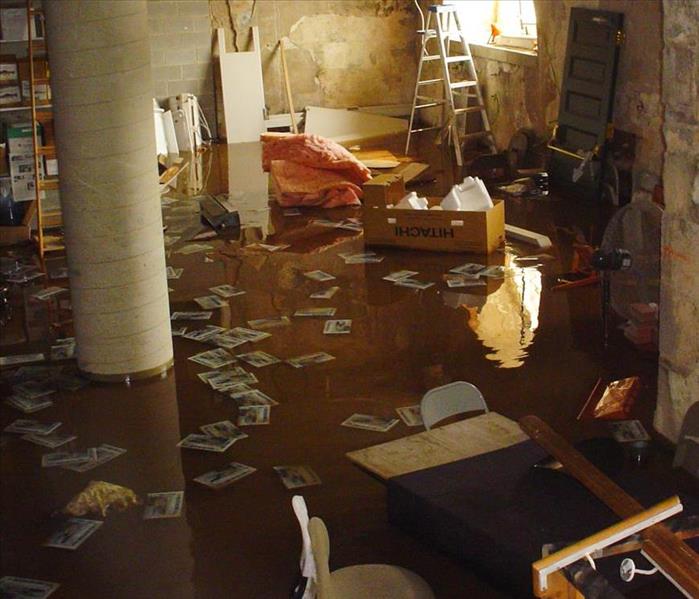
Flooding can happen in a Broome County home or business for many reasons, some related to severe weather or external water supply breaks, and some related to plumbing leaks, broken appliances, or sink and tub overflows by mistake or inattention. When a large amount of water invades, both structural components and the contents of your home are at risk. Our trained crews have many strategies to help you recover from this crisis. When flood damage impacts your home or office, your furnishings, household goods, papers, and other personal articles are often at risk of severe harm. Leaving these portable possessions in your home during flooding remediation also can interfere with the water removal and structural drying necessary to restore soaked building materials. A pack out of contents to a dry area on your property may be necessary to better impact the drying progress of equipment. Removing wet contents allows SERVPRO on-site crews to move through the damaged areas of your home more quickly and efficiently. Water removal, extraction, and structural drying must be completed fast to avoid secondary damage and progressive deterioration of porous materials. When the spaces are cleared, our employees can concentrate on employing powerful water mitigation and drying equipment not on moving boxes and furniture repetitively around the affected areas. SERVPRO inventories and tracks the contents packed out using our Contents Track proprietary program, using bar coding, lists, and digital images to maintain order as we work on restoring items and documenting the process for you and your insurance carrier. Our team members can assist in determining what is salvageable; we will assist in inventorying, and produce the final pack out. When flood damage exposes your home and its contents to potential ruin, a pack out of contents may be necessary. If you experience a flood loss call our office- we can help!
Atlantic Hurricane Season
11/7/2018 (Permalink)
The Atlantic Hurricane season runs from June 1- November 30th. We have one month left. There were a number of tropical depressions this year, with Hurricane Michael being the most severe Hurricane and Weather event along the East Coast this year. It is SO important to insure safety before, during and after a hurricane emergency. Please see the tips below from ready.gov on how to prepare BEFORE for Hurricane Emergencies.
IF YOU ARE UNDER A HURRICANE WARNING, FIND SAFE SHELTER RIGHT AWAY
- Determine how best to protect yourself from high winds and flooding.
- Evacuate if told to do so.
- Take refuge in a designated storm shelter, or an interior room for high winds.
- Listen for emergency information and alerts.
- Only use generators outdoors and away from windows.
- Turn Around, Don’t Drown! Do not walk, swim, or drive through flood waters.
Prepare NOW
- Know your area’s risk of hurricanes.
- Sign up for your community’s warning system. The Emergency Alert System (EAS) and National Oceanic and Atmospheric Administration (NOAA) Weather Radio also provide emergency alerts.
- If you are at risk for flash flooding, watch for warning signs such as heavy rain.
- Practice going to a safe shelter for high winds, such as a FEMA safe room or ICC 500 storm shelter. The next best protection is a small, interior, windowless room in a sturdy building on the lowest level that is not subject to flooding.
- Based on your location and community plans, make your own plans for evacuation or sheltering in place.
- Become familiar with your evacuation zone, the evacuation route, and shelter locations.
- Gather needed supplies for at least three days. Keep in mind each person’s specific needs, including medication. Don’t forget the needs of pets.
- Keep important documents in a safe place or create password-protected digital copies.
- Protect your property. Declutter drains and gutters. Install check valves in plumbing to prevent backups. Consider hurricane shutters. Review insurance policies.
When the Emergency and threat is over, and safety can be insured, we can begin to rebuild and mitigate damage. SERVPRO with over 1,700 Franchises Nationwide will be there READY for Whatever Happens.
Learn More: https://www.ready.gov/hurricanes
Fall Checklist, Getting Ready for Winter
11/7/2018 (Permalink)
As leaves start to fly, revisit your spring cleaning list and add a few seasonal extras to prepare your house for the winter.
The new season should always begin with a fresh start, especially in your home. Is your home ready for the beautiful autumn weather in Upstate NY? We've done our research and with a bit of help from Real Simple, we can help you get through your fall cleaning checklist!
Check out your wooden floors are they scuffed up? See if they need to be sanded or refurbished.
Test all of your home smoke and carbon monoxide detectors; especially as you go through the months with more active fireplaces and with your heat turned up.
Replace Furnace Filters. If you changed your furnace filter in the last three months, now is a good time to do it!
Don't forget the outside of your home too!
Check and clean the gutters before the red and orange leaves fall!
Time to drain and store your garden hoses, don't let them freeze when the first snow falls.
Touch up the paint on your home
Check out the full checklist here! https://www.realsimple.com/home-organizing/cleaning/fall-cleaning-checklist
And if you need an expert to come but to make sure you have your full checklist covered, give SERVPRO of Broome, Tompkins, and Tioga Counties a call. We'll give you and your family a free estimate! (607) 722-2262!
Storm Safety Tips
8/31/2018 (Permalink)
No one likes a rainy day, SERVPRO included. But they do happen, and when a storm strikes both you and your home are at risk. Sudden downpour, power outages, and downed wires are just the tip of the iceberg when it comes to an emergency. The key is to focus on what you can control in times of chaos.
Taking it back to an elementary level (literally) we here at SERVPRO recommend sharing these safety tips with your family, and even reviewing them for yourself!
Follow these 10 Rules from Alliant Energy Kids to stay in control and stay safe:
- Have a storm safety Kit Handy
- Stay Inside During thunderstorms and Blizzards
- Use flashlights instead of candles
- Don’t open the refrigerator or freezer unless you absolutely need to
- If your power goes out, have an adult notify the power company right away
- Don’t try to use a gas appliance to keep warm
- Ask an adult to unplug as many as many appliances as possible
- Don’t play near generators or heaters
- Stay away from damaged or downed lines
- Remind adults to watch out for power lines when they’re cleaning up outside
For the full article visit: http://www.alliantenergykids.com/PlayingItSafe/StormSafety/000562
SERVPRO: Your 365/24/7 Friend
7/26/2018 (Permalink)
 SERVPRO Team
SERVPRO Team
Flooding and water emergencies don’t wait for regular business hours, why would we? As your local SERVPRO we pride ourselves on our proximity and response times, during your emergency. Every second counts (and costs), we know that, and we make it our duty to not waste even one.
Emergencies happen. They can be unpredictable. They can be scary. They can be beat.
SERVPRO’s team of highly trained employees never stop preparing. Each and every SERVPRO team member has been thoroughly trained on fire restoration, water restoration, carpet & upholstery cleaning, and mold mitigation before stepping foot into the field. Together we can beat your emergency.
The fast response times by our highly trained employees are only possible because of our state of the art Fleet of response vehicles. Our fleet of cars, vans, pickup trucks, flatbed trucks, dumpsters trucks, and trailers, provide a vessel outfitted for your specific needs ready at the turn of a key.
We put the best people, in the best locations, and give them the best resources because our clients deserve nothing but the, you guessed it, best.
Dangers of Flash Flooding
3/20/2017 (Permalink)
Flooding is the number #1 weather related cause of death, with majority of those deaths caused by flash flooding. Flash flooding is when there is a large amount of rain that comes down within minutes or hours. Other causes can be heavy rain associated with a severe thunderstorm, hurricane, tropical storm, or melt water from ice or snow flowing over ice sheets or snowfields.
If flooding does occur in your area, please remember
- Listen to NOAA Weather Radio for current and forecasted conditions in your area.
- If flooding begins in your area, go to higher ground immediately.
- When driving, always be aware that the road bed under flood waters may be severely damaged. NEVER drive through flooded roadways. Remember that it takes only two feet of water to carry away a vehicle, including pickups and SUVs.
- When walking, do not attempt to cross flowing streams. Remember that it takes only six inches of rushing water to knock an adult off his feet.
- If your vehicle stalls, get out immediately and go to higher ground.
- Be extra cautious at night, when it is harder to see possible flood dangers.
- These four words could save your life: TURN AROUND, DON’T DROWN.
When it comes to water damage from flooding, safety is the number one priority. When you can insure the safety of your family and conditions have improved, that is when to call in the professionals and assess damage. Our SERVPRO Team is Ready for Whatever Happens.
If flooding does occur in your area, listen to and adhere to weather alerts and warnings and know your risk!
See the link below to learn about some of History’s worst and most extreme recorded Floods in the U.S. https://www.bustle.com/articles/85907-the-8-worst-floods-in-us-history-show-how-devastating-extreme-weather-can-be.
Floods: How to be Ready
2/23/2017 (Permalink)
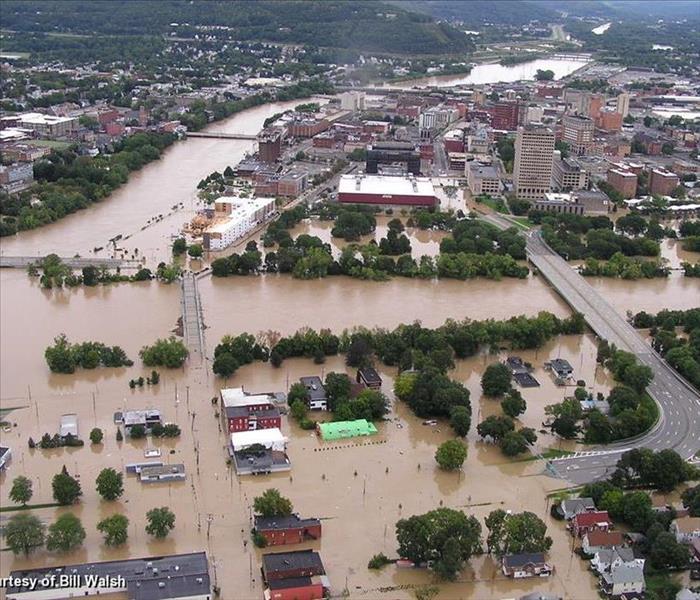 Photo:Courtesy of Bill Walsh
2011 Binghamton Flood. SERVPRO Southside Building.
Photo:Courtesy of Bill Walsh
2011 Binghamton Flood. SERVPRO Southside Building.
There are several times throughout the year when there is potential for flooding. Examples would be melting snow, heavy rain fall for a long period of time, and quick heavy rain that can cause flash flooding. Please read below on how to be prepared and how to stay safe during a flood emergency.
What you can do before the flood
Stay tuned to your phone alerts, TV, or radio for weather updates, emergency instructions, or evacuation orders.
Basic Flood Safety Tips:
- Turn Around, Don’t Drown! ®
- Avoid walking or driving through flood waters.
- Just 6 inches of moving water can knock you down, and 2 feet of water can sweep your vehicle away.
- If there is a chance of flash flooding, move immediately to higher ground. Flash floods are the #1 cause of weather-related deaths in the US.
- If floodwaters rise around your car but the water is not moving, abandon the car and move to higher ground. Do not leave the car and enter moving water.
- Avoid camping or parking along streams, rivers, and creeks during heavy rainfall. These areas can flood quickly and with little warning. Please visit Ready.gov for more information on how to stay prepared for all types of emergencies!
Our region is an area that has flooded in the past, and has the potential to flood again the future. It is extremely important to know how to stay safe during a flood emergency, and also how to prepare in advance of a flood.
Preparing for Winter Storms
1/23/2017 (Permalink)
Winter in Upstate NY can sometimes be unpredictable. Weather can change from week to week, but one thing we know for sure is the winter season will be here for a few more months.
The American Red Cross has great tips we would like to share, from what to do during the storm, to what we can already have on hand in your home emergency supply kit.
Remaining Safe During a Winter Storm
- Listen to a NOAA Weather Radio or other local news channels for critical information on snow storms and blizzards from the National Weather Service (NWS).
- Bring pets/companion animals inside during winter weather. Move other animals or livestock to sheltered areas and make sure that their access to food and water is not blocked by snow drifts, ice or other obstacles.
- Running water, even at a trickle, helps prevent pipes from freezing.
- All fuel-burning equipment should be vented to the outside and kept clear.
- Keep garage doors closed if there are water supply lines in the garage.
- Open kitchen and bathroom cabinet doors to allow warmer air to circulate around the plumbing. Be sure to move any harmful cleaners and household chemicals up out of the reach of children.
- Keep the thermostat set to the same temperature both during the day and at night. By temporarily suspending the use of lower nighttime temperatures, you may incur a higher heating bill, but you can prevent a much more costly repair job if pipes freeze and burst.
- Go to a designated public shelter if your home loses power or heat during periods of extreme cold.
- Avoid driving when conditions include sleet, freezing rain or drizzle, snow or dense fog. If travel is necessary, keep a disaster supplies kit in your vehicle.
- Before tackling strenuous tasks in cold temperatures, consider your physical condition, the weather factors and the nature of the task.
- Protect yourself from frostbite and hypothermia by wearing warm, loose-fitting, lightweight clothing in several layers. Stay indoors, if possible.
- Help people who require special assistance such as elderly people living alone, people with disabilities and children.
Please see the link below for further information on putting together a home supply kit for winter emergencies!
http://www.redcross.org/get-help/prepare-for-emergencies/types-of-emergencies/winter-storm#Prepare
SERVPRO Storm Response
1/10/2017 (Permalink)
When it comes to fire & water damage, or specialty cleanup needs, it’s the SERVPRO brand that comes to mind. Our TEAMS work endlessly to make sure our customers are happy, and have one objective in the aftermath of disaster, to make their loss Like it never even happened.
No matter the job or the size, our SERVPRO teams are ready to handle any size loss. With 1,700+ franchises nationwide, we have access to numerous highly trained personnel and thousands of pieces of equipment. Our SERVPRO Disaster Recovery teams are strategically placed throughout the country to respond when needed. Our Teams have a proven track record for success, assisting with cleanup of floods, tornadoes, wildfires, and damage caused from frigid temperatures.
Whether it’s a major storm event, or faulty appliance, we will be there with one call. 607-722-2262.
Water in the Winter
1/3/2017 (Permalink)
Happy New Year!
As the area’s weather is still ever changing from the 10’s to the 40’s, we may see on and off again snowfall, melting snow, and then again frozen. This can at times wreck havoc on your property. Water intrusions can happen through the roof, walls, windows, or any area not completely sealed---not to mention leaking appliances or broken pipes.
If there is ever a time water damage is noticed, no clean up is “too small”. It is important to address any and all water/moisture issues. The water you see, or not see for that matter, if its trapped in insulation or behind a wall surface, can contain bacteria, cause mold, rot, odor, or other unseen damage. No matter the size, call in one of our professionals for free to do an initial free assessment/ estimate of the damage.
Remember Safety first when it comes to water cleanup. If you can, prevent further damage on your own while waiting for one of our professional team members. If not we will follow up on- site quickly to…
- Identify the source/ type of water
- Measure temperature and humidity for drying analysis
- Survey the Extent of Damage and inspect the premises.
- Perform Emergency Water Extraction.
- Apply necessary Treatments.
- Utilize drying equipment and monitor drying
We will work with you and your insurance company, if you have opened a claim, throughout the water remediation process.
REMEMBER don’t let water of any type sit- call us in and we will be there!
First Day of Winter: Winter Storm Prep!
12/19/2016 (Permalink)
December 21st marks the first day of winter! Upstate NY sometimes has unpredictable weather, we can be surprised by some mild weather and the sun shining….but for the part we know we will see some of those freezing temperatures and Winter storms! It is important to have your home and business ready!
Take a look at some of these Winter Storm Safety Tips from the American Red Cross:
- Winterize your vehicle and keep the gas tank full. A full tank will keep the fuel line from freezing.
- Insulate your home by installing storm windows or covering windows with plastic from the inside to keep cold air out.
- Maintain heating equipment and chimneys by having them cleaned and inspected every year.
- If you will be going away during cold weather, leave the heat on in your home, set to a temperature no lower than 55° F.
Not following these tips for your property could potentially wreck havoc on your winter season from broken pipes to chimney fires!
SERVPRO wants you to stay safe! If your home or business ever suffers from the cold weather causing issues from water or smoke damage, give us a call and we will be there!
Lightning Safety Awareness Week!
6/23/2016 (Permalink)
It’s the first week of summer and we’ve already had our first night storm. It’s good to be knowledgeable about the potential dangers of lightning at all times of the year, but it’s Lightning Safety Awareness Week we thought it would be a good time to share some details. Surprisingly, lightning is the third greatest storm-related killer in the United States. It is commonly underestimated because many people don’t believe that it could happen to them. However, on average, lightning will kill about 37 people directly, cause 300 injuries and $1 Billion in damages each year. It is important to know that there is no safe place outside when there is a thunderstorm in the area. Even when inside, it is still possible that your home can be struck by lightning as well. Lightning causes about 4,400 home structure fires each year. WOW that’s quite a few.
Learn more! Check out these helpful tips on what to do if this happens to your home. And don’t forget you can always call us for the clean up!
http://1.usa.gov/28PPOIE
Hurricane Preparedness Week (May 15 - May 21)
5/16/2016 (Permalink)
Hurricane preparedness week is here! It only takes one disaster to change the community you live in forever. Hurricanes are powerful and destructive so it is important to be aware of the necessary preparation. If you live in an area on the coastline it is important to be prepared and even areas distant from water can be threatened by flooding, winds and tornadoes.
This week it is important for you to prepare for potential tropical storms or hurricanes.
Check out the site below for daily tips and other links to ensure your prepared for any storm! http://www.nws.noaa.gov/com/weatherreadynation/hurricane_preparedness.html
If a hurricane storm has affected your area and its time to rebuild, the Red Cross suggests calling in a professional when it comes to:
- Ensuring roof sheathing is properly installed.
- Ensuring end gables are securely fastened to the rest of the roof.
- Fasten the roof to the walls with hurricane straps.
- Elevate your home if it is near the coast and subject to flooding from storm surge.





 24/7 Emergency Service
24/7 Emergency Service

